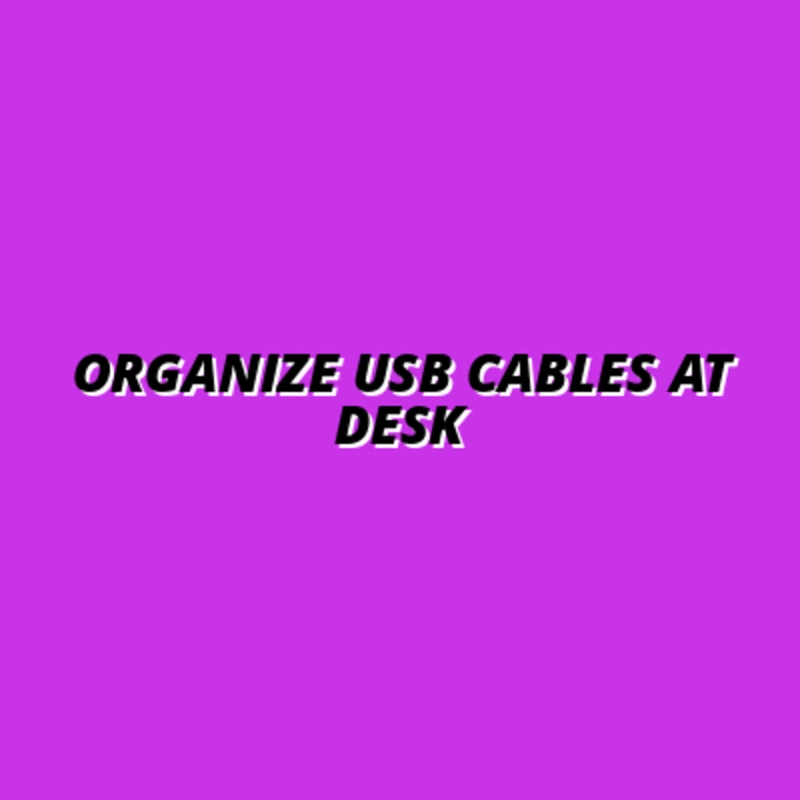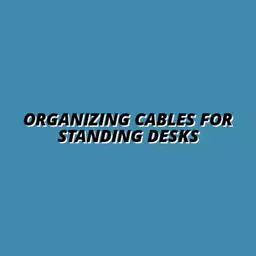Improved Aesthetics
A clean and organized desk is visually appealing, reducing visual clutter and enhancing the workspace atmosphere.
Effective USB cable management can significantly enhance your workspace, leading to improved organization and productivity. By understanding the challenges of cable clutter and implementing strategic solutions, you can create a more efficient and aesthetically pleasing environment. Let’s explore the key takeaways from this article that will help you master your cable management skills!
Organizing your USB cables leads to significant improvements in aesthetics, productivity, and safety, as outlined below:
A clean and organized desk is visually appealing, reducing visual clutter and enhancing the workspace atmosphere.
Less time spent searching for cables translates to more time dedicated to tasks, boosting overall productivity.
Properly managed cables reduce the risk of tripping and damage, creating a safer work environment.
Implementing effective routing methods can significantly enhance the overall look and functionality of your workspace.
If you’ve ever dealt with a jungle of tangled cables at your standing desk, you’re not alone! Cable clutter can be a significant distraction, making it hard to focus on your work. But don’t worry—effective USB cable management can transform your workspace into a haven of organization and efficiency.
When your cables are organized, not only does your desk look cleaner, but it also makes it easier to find and connect devices. Plus, a tidy workspace can positively impact your productivity and mental clarity. Let’s dive deeper into why knowing how to manage those USB cables is essential!
The challenges posed by cable clutter are all too familiar. It can create a chaotic environment, leading to frustration when trying to find the right device or charging cable. With multiple devices like your mouse, keyboard, and phone all using USB connections, the potential for tangles is high!
So, what are the benefits of effective management? Here are a few key points to consider:
💡 Need a full cable management strategy for standing desks? Check out our complete guide to managing cords, motor wires and accessories. 👉 Read the Cable Management 101 Guide
Before you can tackle cable management, you need to assess your current setup. This helps identify specific needs and challenges unique to your workspace. Start by examining the following areas:
By understanding your workspace's layout and requirements, you can begin to devise a tailored plan for organizing those USB cables effectively. Remember, a little planning goes a long way in achieving a neat and efficient work environment!
Here's a brief recap of the key points discussed so far:
Before diving deeper, let's address some frequently asked questions about USB cable management:
A: Effective cable management enhances aesthetics, productivity, and safety by reducing clutter and preventing trips.
A: Measure the vertical distance from your USB port to the highest point of your desk, add at least 12 inches for slack, and consider the horizontal distance if your devices are positioned away from the desk.
A: Reuse household items like toilet paper rolls, create DIY cable sleeves, or use binder clips to keep cables in place.
A: Labeling cables with color coding, tags, or numbering systems makes it easier to identify which cable belongs to which device, saving time and frustration.
A: Route cables along the edges of your desk, use cable management solutions like trays or clips, and separate power cables from data cables to minimize interference.
Finding the right length for your USB cables can be a bit tricky, especially when you’re using a sit-stand desk. Generally, you want to ensure that your cables are long enough to accommodate any height adjustments without creating slack. A simple guide to follow is to measure the distance from your USB port to the device while the desk is at its highest setting, then add an extra foot to allow for movement.
Here’s a quick formula to help you calculate the optimal length:
By following this method, you can ensure that your USB cables are just the right length, avoiding both clutter and potential damage!
In the world of cable management, labeling is your best friend! If you’ve ever found yourself tangled in a web of cables, you know how important it is to easily identify which cable belongs to which device. Implementing a labeling system can save you time and frustration. Here are a few practical methods:
With these strategies, you’ll never have to guess which cable is which again—talk about a game changer! For more insights, explore helpful workspace tips on labeling cables effectively.
Effective cable routing can significantly enhance the overall look and functionality of your workspace. At Standing Desk Center, I’ve learned that a tidy setup not only looks better but also helps improve ergonomics. Here are some strategies to consider:
These routing practices will help maintain a clean and organized workspace, allowing you to focus on what truly matters—your productivity!
Managing USB cables doesn’t have to break the bank! There are plenty of creative and budget-friendly DIY solutions available. Here are a few hacks that I’ve found particularly effective:
Implementing these hacks will not only save you money but also give your workspace a personal touch! For additional cost-effective ideas, check out clever ways to hide desk cables.
Adhesive cable mounts and clips are a fantastic way to keep everything in check. These small devices can easily stick to your desk or walls, allowing you to secure cables wherever you need them. Here’s how you can make the most of these handy tools:
By utilizing these mounts and clips, you can effectively reduce clutter and keep your workspace looking sharp.
In conclusion, having an organized workspace can immensely improve your productivity and overall well-being. By implementing the strategies we’ve discussed—like calculating cable lengths, labeling, and routing—you can create a tidy, efficient environment. Remember, a little effort goes a long way in maintaining a clean setup!
Let’s wrap it up: start small, pick one or two tips to implement today, and watch your workspace transform. Looking for more ways to organize cables for your desk? I’d love to hear your thoughts and any tips you've found helpful on this journey!
Here is a quick recap of the important points discussed in the article:

 Effective cable management can transform your home office from a chaotic mess into a sleek workspace
Effective cable management can transform your home office from a chaotic mess into a sleek workspace
 In today's fast-paced digital world, a disorganized workspace can lead to distractions and decreased
In today's fast-paced digital world, a disorganized workspace can lead to distractions and decreased
 What if the key to a more productive workspace is simply organizing your cables? With magnetic cable
What if the key to a more productive workspace is simply organizing your cables? With magnetic cable
 What if a simple adjustment to your workspace could unlock your creative potential? Cable management
What if a simple adjustment to your workspace could unlock your creative potential? Cable management